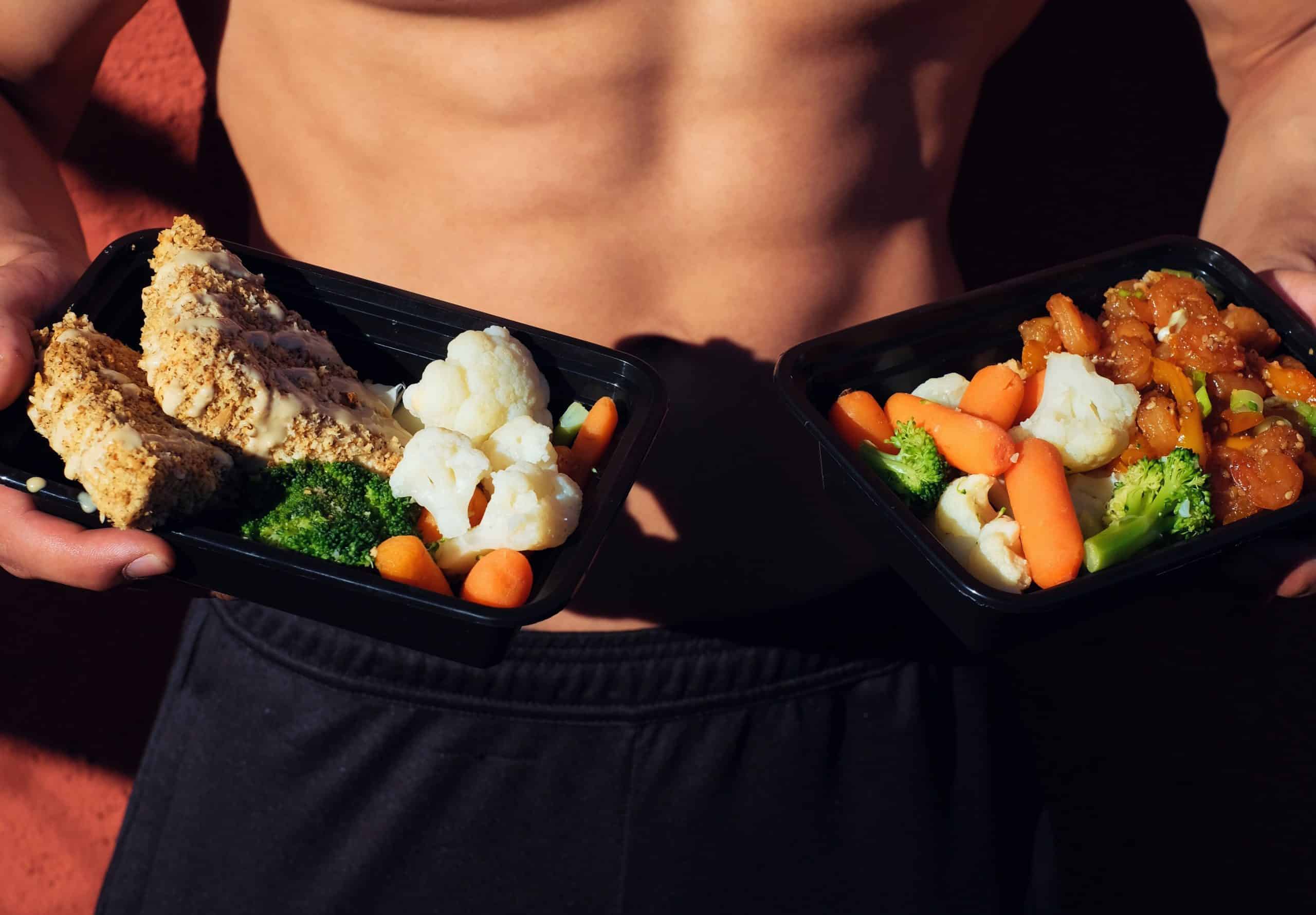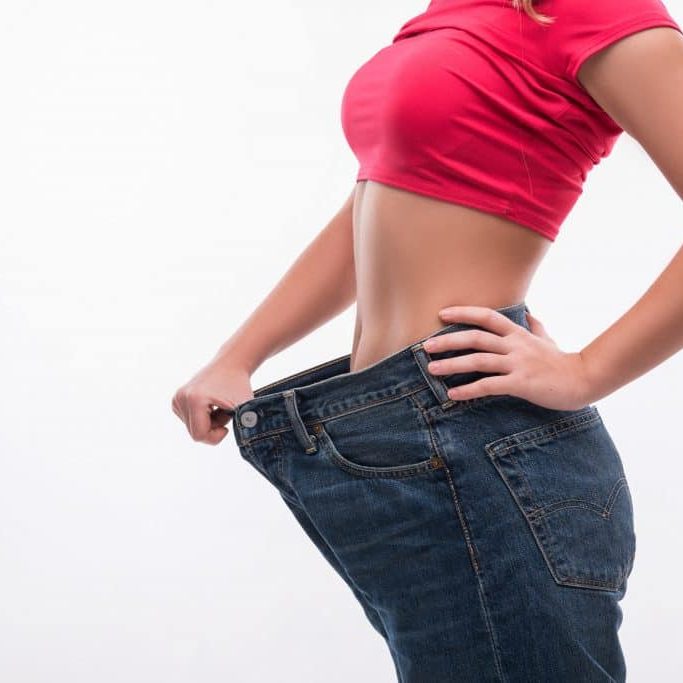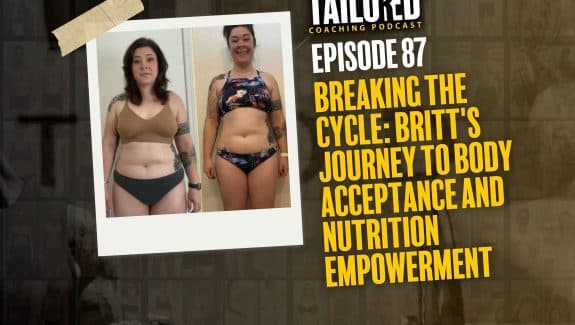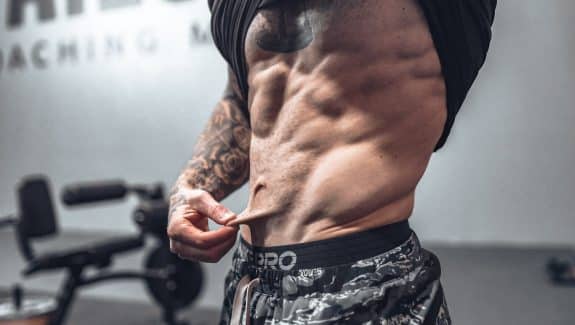First we need to define and differentiate the different kinds of diets you can follow to see progress.
For the context of this article, we’re going to dismiss things like paleo or keto dieting because those are specifically eating styles, rather than fat loss diets. Can they cause fat loss? Sure, they absolutely can… but not without also accomplishing a calorie deficit.
Therefore when we consider what the best approach is for a fat loss diet, we are specifically talking about calories and macros. With regards to that, there really are only two specific ways of setting up your diet to achieve a calorie deficit with the right macros — in order to help you accomplish your fat loss goals… Well, more specifically I’d say that there are two main ways that are most frequently used by those dieting for fat loss and they’re also likely the best suited for achieving fat loss results.
First, there’s flexible dieting…
Flexible Dieting For Fat Loss
Flexible dieting is commonly mixed up with IIFYM (if-it-fits-your-macros), because they are very similar with regards to how they accomplish fat loss for any individual. They both require that you track your food in a food logging app, to record your calories and macros.
However, they’re different in many regards – specifically because IIFYM was built by taking Flexible Dieting out of context and into the ideology that {macro} numbers are all that matter. But this disregards nutrient timing, hydration, sodium intake, micronutrients, and so much more. Many of which do matter, quite a lot!
Whereas Flexible Dieting prioritizes the caloric and macronutrient value of a food, allowing you to be flexible with your diet while still seeing results. This is primarily because when it comes to losing weight or body fat, your calorie is the number one priority in achieving success.
A simple way to understand this would be the example of an individual eating paleo, but being in a calorie surplus. See, a paleo diet is rich with micronutrients – you’re eating loads of fruits, veggies, lean meats, eggs, and so much more! All of which is packed with vitamins and minerals. You’re also eliminating sugar, processed foods, etc…. So this has GOT to be a healthy diet, that would encourage fat loss…. Right?
Well, yeah – so long as you’re in a calorie deficit. But even if you’re eating the healthiest diet in the world, but still remain in a calorie surplus… you will not lose weight. In fact, you would gain weight because you’re in a surplus. This is why the best diets for fat loss are all going to promote a calorie balance that is in favor of losing weight (i.e. caloric deficit). For more on the explanation of this and how to find the best diet for you, check out this free article I wrote.
What this means is that calories are what matter most in regards to body composition changes and therefore the best way to accomplish fat loss is creating a calorie deficit.
However, the best way to create health is a combination of food quality AND fat loss. Being lean and avoiding obesity is the most influential factor in overall health and wellbeing. After that comes vitamins, minerals, fiber, hydration, etc… So it’s with a combination of these that we achieve both health AND fat loss.
This also does not mean that drinking a beer on occasion or fitting some ice cream into your daily calorie intake makes you unhealthy!
Which is where flexible dieting comes into play and works fantastically well at helping people achieve fat loss success. This way of dieting allows us to set up our calories and macros to accomplish the body composition changes we desire, while also helping us set boundaries for our intake so that we can include enough of the foods that lead to better health AND just enough of the junk food we love to make the diet easy to adhere long-term.
There’s only two primary problems we see with flexible dieting, and that’s when (1) people become TOO flexible with their diet, eating loads of inaccurately-labeled processed foods or restaurant dining too often, and (2) when the lack of structure leads to an inability to plan meals out ahead properly, have any serious accountability, and ultimately a lack of adherence or consistency.
Which is where our second route of dieting comes into play, which are meal plans…

Meal Plans For Fat Loss
The image that plays out in our minds when we envision a meal plan is often a super-jacked bodybuilder, holding a tiny tupperware filled with chicken and broccoli, maybe even some brown rice… Or maybe a pinterest picture that has an entire dining room table filled with 37 of those little tupperwares of chicken and broccoli!
Did I take the picture out of your mind or what?!
I’m sorry to burst your bubble, but that’s just not the reality here.. The truth is, a meal plan doesn’t even have to be prepped ahead of time! Which is where most people misconstrue the term ‘meal plan’ – a meal plan is a plan, NOT a meal prep.
Therefore you can have a flexible dieting based meal plan, which is actually exactly what I recommend and use with my most successful clients over the years. More on that below, when we compare the two…
To further elaborate on what a meal plan is; a meal plan is a predetermined set of meals that meets your total daily requirements, for both calories and macros, and typically gets repeated daily for success.
The reasons these are so common in the bodybuilding world…
IS BECAUSE THEY WORK!
And it’s no coincidence that bodybuilders are more successful than everyday people at both getting lean, generally, as well as getting lean by a specific deadline.
Meal plans are created with almost entirely simple ingredient, whole food based choices. This more “rigid” selection can be draining, psychologically speaking, for some individuals because of the repetitiveness and the lack of variety… However, it eliminates the inconsistencies that food labels have, which is one of the primary reasons flexible dieting can yield progress at a certain point. And even in the circumstance that an item in a meal plan is inaccurately measured from the very beginning, it becomes an unchanged variable! Which is less of a liability in the diet than constantly changing that inaccurately measured food item.
Meal plans also create a greater amount of structure than flexible dieting does. Which is nice for many individuals who are busy, due to work or family obligations. This allows them to just follow the plan and watch the results happen, so long as they don’t get bored of the foods they’re eating (which sounds like it’d be a more common issue than it actually is, if the meal plan is set up properly by the coach).
There’s even research to show that repeating food groups within a diet, day after day, can lead to less cravings and a lower likelihood of over-eating, compared to a diet that has a lot of variety or infrequent amounts of random free or cheat meals in it.
Lastly, I want to make note about something that is commonly asked when discussing meal plans and repeatedly eating the same foods… and that’s “food sensitivities”. The term “food sensitivity” isn’t backed up by much research and food sensitivity tests have been debunked countless times, so it’s hard to provide much real context to these (compared to food allergies, which typically are genetic, autoimmune related, or caused by rare circumstances).
However, leaning on anecdotal evidence (people’s individual experiences) we can acknowledge that some people’s body’s simply disagree with certain foods and have a more difficult time digesting them. This is not life threatening and is unlikely caused by repetitively eating the same food, but rather by another cause during the consumption of the food.
So what’s the issue with meal plans, then?! They seem great, right??
Well, they do provide more structure and reliability for accuracy and adjustments.
They may decrease cravings and overeating, but they may also trigger occasional binges for some people who overly restrict themselves while following the meal plan.
And if the main reason they work is to create a calorie deficit, I guess you don’t NEED to follow them…
What’s Better For Fat Loss:
Flexible Dieting vs. Meal Plans
What’s better? Well, before I write out that answer… Just know that there’s some studies on this actual debate! And since we have a researcher on staff, we had him write an article reviewing the main study on the topic. You can read that right here; Is Flexible Dieting Good For Weight Loss? IIFYM vs. Meal Plans.
Secondly, I (Cody McBroom) recorded a YouTube video on my channel diving into this exact topic! In the video, I lay out the difference between the two, how the study mentioned above went down, what the results in the study were, AND whether or not this pans out in the real world scenarios without clients at Tailored Coaching Method. Watch it below:
To summarize the video, the study, and the article we created… Here’s what the real answer is, to whether or not a Meal Plan or Flexible Dieting is better for fat loss:
NEITHER IS BETTER! It depends on the person and the situation. But most likely, it’s a combination of the two that works best.
– If you create a meal plan, you are developing structure and you are having some autonomy in the decisions of what foods go into that meal plan. This gives YOU control and that’s more empowering than being told what to eat.
– Without having daily calories and macros determined, a meal plan will not provide the results you desire to achieve. So with that meal plan, you also need to know and understand where your total daily intake needs to be (both calories and macros).
– Taking it a step further, planning your meals out by macros first is key because it allows you to properly distribute your protein, fats, and carbs throughout the day. This is going to help with satiety, recovery, digestion, and performance (potentially even your circadian rhythm). What this also does is allow you to more easily make swaps on a meal by meal basis, in the circumstance where you cannot get to the meal that is written out for you in your plan.
– Having a meal plan gives you structure and repetitiveness, to make day to day eating less tedious to track – while also more accurate (which produces better results)! However, having the total daily calorie and macro target to fall back on, you can also have certain days within the week (1 or 2, recommended) that you do not follow the meal plan and you do have a more “IIFYM” style day, to enjoy some social eating or to simply eat some foods that aren’t on your current meal plan. This goes a long way for the psychological aspect of dieting and the fatigue dieting can bring on mentally, much like the benefit a diet break would provide you with.
Ok, so now we know it’s not ONE vs. the OTHER, but rather a COMBINATION that leads to the greatest amount of fat loss success.
There’s only one thing left to do here…
How to Create A Fat Loss Meal Plan
Creating a fat loss meal plan boils down to 5 specific steps, which I outline for you in as much detail as necessary below. Then, after the 5 steps to help you create a fat loss meal plan, I’ll share with you an example meal plan that can be adjusted depending on your total daily intake AND a video where I share my entire day of eating (so you can see how I personally use this structure to create my own meal plan, too).
Step #1
Determine your calorie intake and macro targets. This is your base and your foundation. It is the most definitive aspect of losing body fat or gaining muscle mass (weight), because the calorie balance determines the body composition response more than anything else does or ever will.
Step #2
Decide how many meals per day you’d like to eat (and can consistently adhere to). This is your blueprint and without it, you cannot move forward into the rest of the steps – as they rely on this total number of meals.
Step #3
Take your daily total protein intake and divide it by the number of meals you plan to eat. This will allow you to optimize your muscle protein synthesis response to your daily intake, leading to better recovery and muscle growth progress. This also increases your satiety rate from the diet, being that protein is the most filling macronutrient of the 3 macros.
Step #4
Determine what time you’ll train and portion your carbs more heavily around that meal. An easy way to determine how many carbs you should place around these meals would be to take roughly 20-40% of your total daily carb intake and place that before and after your training session.
As an example, if you’re consuming 300g of carbs – the average amount to use would be 90g pre and post workout. If you had 5 meals total for the day, that’d leave you with 120g of carbs to distribute across 3 meals, which is 40g per meal. That’s a general range and truly only becomes more important as you lean deeper into a deficit and have lost a lot of fat, since you’ll have a smaller intake and less fat stores on your body (i.e. more likely to be glycogen depleted in that state).
Step #5
Place a small amount of fat in your pre and post workout meals, while then distributing the rest evenly throughout the day. Fats spread evenly is fine, too, as it helps with digestion rates and satiety (i.e. slows digestion down of a meal). However, too much fat in a pre or post workout meal may slow digestion down too much, in a setting where we would benefit from faster digestion rates. Recent research suggests that worrying about this in the post workout feeding may not provide much benefit, if any at all. But in the pre workout window it is still important to have some, to avoid a huge insulin surge and going hypoglycemic, while also ensuring your pre workout carb source digests at a moderate pace (sustainable energy levels throughout your session). But if you consume too much, your gut will be churning as you’re pressing plates on the leg press – which isn’t going to help your performance!
Step #6
Fill in the final macros with leftover carbs, prioritizing micronutrient dense sources! Now you would simply fill in the leftover macros with any carbs you have leftover, to reach your daily totals. When doing this, it’s important to choose fruit (1-3 servings/day), veggies (2-3 servings per day), and fiber-dense starches (oats, sweet potatoes, whole grains, etc.). This is our way of ensuring we’re getting a variety of healthy foods, as well as meeting our macros.
Example Fat Loss Meal Plan
| 5 Meals
(Eaten Every 3-5 Hours) |
Other | Protein | Carb | Fat |
| Meal #1 | Fish Oil, Multivitamin, etc… | Egg Whites | Whole Wheat Toast + Mushrooms & Spinach | Egg Yolk + Olive Oil |
| Meal #2 | 93-96% Lean Ground Beef or Bison | Diced Sweet Potatoes + Brussels | None Added (Fat From Beef) | |
| Meal #3
(Pre Workout) |
Greek Yogurt + Whey Protein Powder | Old Fashioned Oats (Dry) + Blueberries | Almond Butter | |
| Meal #4
(Post Workout) |
Creatine Monohydrate | Grilled Chicken Breast | Rice or Potatoes + Roasted Veggies | Olive Oil |
| Meal #5 | Casein Protein, Cottage Cheese, or Greek Yogurt | Frozen Fruit (Berries, Bananas, Cherries, etc.) | Almond Butter or Dark Chocolate |






















































































































































































































































































































































































































































































